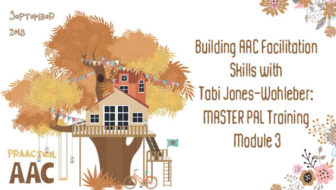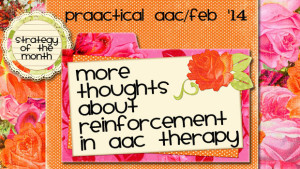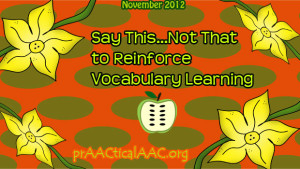Tag Archive: reinforcement
September 6, 2018
by Carole Zangari -

Our training series continues with West Virginia-based SLP Tabi Jones-Wohleber, who works with the AT Team for Frederick County Public Schools in Maryland and provides services to infants and toddlers in the West Virginia Birth to Three programs. In the first two posts, Tabi shared the Overview and Modeling modules and their accompanying resources. In today’s post, the training focuses on an important topic, motivation. ::::::::::::::::::::::::::::::::::::::::::::::::::::::::::::::::::::::::::::::::::::::::::::::::::::::::: Model as a MASTER PAL Module 3: Motivate Facilitator Guidelines Genuine motivation goes well beyond gummies and goldfish; reinforcers are only one small part of the picture as we endeavor to understand what truly drives an individual’s desire to learn and communicate. So much of the time it is the quality of the relationship and the meaningfulness of the interaction. This module discusses the importance of motivation in learning and engaging, whether intrinsic or extrinsic, as well as the undesirable consequences that occur when lack of motivation... [Read More...]
Filed under: Featured Posts, PrAACtical Thinking
Tagged With: AAC partner training, motivation, reinforcement, Tabi Jones-Wohleber
October 14, 2016
by Carole Zangari -

One of the best ways to enhance our teaching is to understand and respect the things that motivate our learners. We are all motivated by different things, though, and sometimes it can be hard to figure out the specifics of what a particular learner likes well enough for it to be used as reinforcement. Sometimes it’s easy. We all know kids who would do anything for [iPad time; Thomas the Tank Engine, Super Why, Pokemon, Hello Kitty] or [you fill in the blank]. We can use those in formal and informal ways to keep these learners motivated and engaged. And that’s important because, often, what we are asking them to do is hard. But sometimes, we work with people for whom those ‘magic motivators’ aren’t so clear. The ‘typical’ reinforcers don’t seem to work for those folks, and that can slow down progress. How can we figure out what motivates... [Read More...]
Filed under: Featured Posts, PrAACtical Thinking
Tagged With: forms, preferences, reinforcement, teaching
February 17, 2014
by Carole Zangari -

When we’re teaching AAC, our preferred means of responding to learners is with natural consequences, expansions, extensions, and verbal encouragement. Here are some of our prAACtical thoughts. Natural Consequences Nothing says ‘power’ like having someone respond based on what you just said. SLPs are quite familiar with this concept and use this regularly to provide ‘more’ tickles, crackers, and music. When we work with beginning communicators, we’re all about providing quick access to whatever the AAC learner requests. But we tend to lose sight of the need for natural consequences when working with learners on higher level language skills. True, it is more difficult to think of the natural consequence when we’re working on morphology, syntax, and semantics, but the principle is the same: Learning is enhanced when our responses are driven by the message that our client just produced. We’re working with Antonio to reduce ambiguity in his messages.... [Read More...]
Filed under: Strategy of the Month
Tagged With: encouragement, expansions, extensions, natural consequence, reinforcement, token board
November 14, 2013
by Robin Parker -

Vocabulary Reinforcement- Worth Repeating (originally published 11/15/12) Part of TEACHING vocabulary to AAC users (or any learner) involves reinforcement. Reinforcement is more than just facilitating positive self esteem. It is also about providing feedback that will help increase the skill you are trying to teach. It’s more than learning specific new words but also about strategies to attack learning new words outside of the therapy or classroom environment. Below are some examples of ways to make the most of your reinforcement and some ways to NOT. (click for some great written reinforcement examples). 🙂 SAY THIS… General Principles of Reinforcement for Vocabulary: Be specific to the goal. Use words that explain the skill you want to occur more often. Use excited positive vocal inflection, Be impressed! We are continuing with the example of teaching the word consumed from Carole’s post on Monday, What Makes A Good Vocabulary Teaching Activity. ‘Wow you discovered a... [Read More...]
Filed under: PrAACtical Thinking
Tagged With: Learning, reinforcement, vocabulary
November 15, 2012
by Robin Parker -

Part of TEACHING vocabulary to AAC users (or any learner) involves reinforcement. Reinforcement is more than just facilitating positive self esteem. It is also about providing feedback that will help increase the skill you are trying to teach. It’s even more than learning specific new words but also about strategies to attack learning new words outside of the therapy or classroom environment. Below are some examples of ways to make the most of your reinforcement and some ways to NOT. 🙂 SAY THIS… General Principles of Reinforcement for Vocabulary: Be specific to the goal. Use words that explain the skill you want to occur more often. Use excited positive vocal inflection, Be impressed! We are continuing with the example of teaching the word consumed from Carole’s post on Monday, What Makes A Good Vocabulary Teaching Activity. ‘Wow you discovered a NEW WAY of saying take in, you used consumed’! ‘Awesome... [Read More...]
Filed under: PrAACtical Thinking
Tagged With: Learning, reinforcement, vocabulary
September 30, 2012
by Carole Zangari -

This week, we’re heading back to the Autism and Tertiary Behavior Supports Project of the Kansas Technical Assistance Network. They have two wonderful videos by Lori Chambers on Picture Exchange Communication System (PECS). – You can view an overview of this approach here: Part 1 and Part 2 . Also, look for the handouts that accompany these videos. –
Filed under: Video of the Week
Tagged With: ASD, implementation ideas, intervention, PECS, reinforcement
January 4, 2012
by Robin Parker -
Mama always said that if you don’t have anything nice to say, then don’t say anything at all. – True enough, but sometimes people who mean to be nice, need a little bit of guidance. If you’ve ever cringed when someone said ‘Good pointing’ or ‘Nice talking,’ well, you know what I mean. Having SLPs in the classroom to support students who use AAC makes sense for many reasons. Among them is the opportunity to model appropriate interaction styles so that adults and non-disabled peers can learn by observation. With that in mind, we offer up some suggestions for great things to say to encourage communicative competence and self-esteem. “I like what you said.” “That’s a good way to say that!” “Can you teach that to ___ ?” “Here’s another way to say it.” “Take your time. I’m not in a hurry.” –
Filed under: PrAACtical Thinking
Tagged With: feedback, reinforcement





